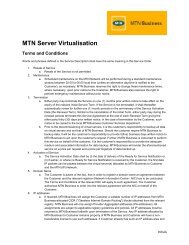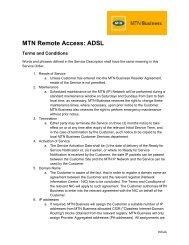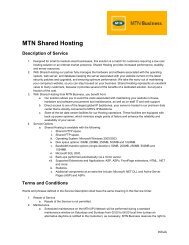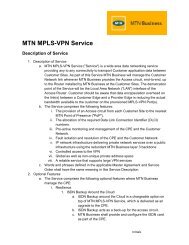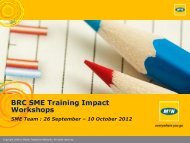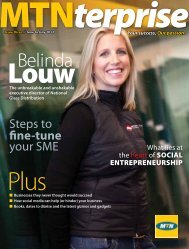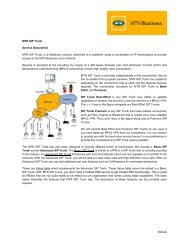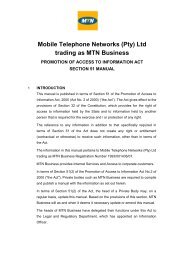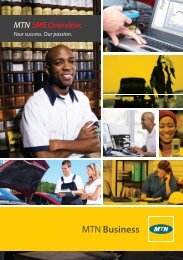SME Mag_Issue 2.pdf - MTN Business
SME Mag_Issue 2.pdf - MTN Business
SME Mag_Issue 2.pdf - MTN Business
You also want an ePaper? Increase the reach of your titles
YUMPU automatically turns print PDFs into web optimized ePapers that Google loves.
forecastThe year aheadTough times on the horizon, but good news is on our doorstepWhat’s the economic forecast for 2012? Let’s getthe bad news out of the way first, because it’sgrim indeed; the good news, on the other hand,is better than good – it’s great.According to Dr Adrian Saville, chief investment officer ofCannon Asset Managers, “The single biggest headline issuein the advanced world is that Europe and the United Statesare going to remain troubled economic regions… There isan overwhelming possibility that Europe will go back intorecession in 2012, and a 75% chance that the US will followit. That’s not good news for South Africa because of our stillcloseeconomic association with these geographies. If Europeand the US are going to have tough times, this will translateinto tough times for us as well.”However, in this light, there is a second critical issuefacing South Africa: the extent to which we can mitigatethe recession by tapping into the energy of the “dynamicmarkets”. They include the well-known BRIC countries (Brazil,Russia, India and China) but are by no means limited tothem. Turkey, for instance, was one of the world’s fastestgrowing economies in 2011, and in that same year the Turkishcompany Arçelik bought up the South African manufacturerDefy Appliances for R2.5-billion.“Those bridges into dynamic markets are incredibly importantfor our prosperity,” Dr Saville said. “Turkey is an example,but there are others. While some, such as Vietnam and thePhilippines, are further afield, many of the vibrant economiesare close to home. Over the past 10 years, Angola has been thefastest growing economy in the world, and is then potentiallya very important partner for South African businesses.”For Dr Saville, these “bridges” into the continent’s dynamicmarkets hinge on two things: the state-level policies thatare put in place to enable them, and the ground-levelinfrastructure that is built to make them a reality.“Currently, one of the single most important initiatives isthe Grand Free Trade Agreement, which will run from SouthAfrica through southern Africa and into East and West Africa.If it’s put together successfully, it will result in a free-tradezone that includes about 600 million consumers. It’s a seriousand real initiative… Today’s South-East Asian countries doabout two-thirds of their trade with each other; in sub-Saharan Africa, only 15% of our trade is with each other…Yet our neighbours are these fast-growing economies suchas Angola, Rwanda and Mozambique.”Infrastructure is being developed to support these policyinitiatives, a good example being the Maputo Corridor thatconnects South Africa’s northern provinces to Mozambique’scapital port. “Infrastructural investments of this kind areimportant for economic welfare and will be good for smallerbusinesses, which are likely to find incredible opportunities inthese new frontiers.”Take cellphones, for example. Dr Saville points out thatthere are an estimated 600 million handsets in sub-SaharanAfrica, which “makes the [telecommunications] marketbigger than the US or Europe. Handsets require a range ofdifferent inputs, whether it be electrification, cellular towers,the servicing of broken handsets, the sale of airtime andconnectivity, or the development of applications.”Similarly, a surge in building is happy news for those inthe construction sector, but – thanks to what economistscall multiplier and spillover effects – its impact grows andspreads indirectly to other sectors. “It means that goodsneed to be moved, which is good for transport firms; itmeans that buildings need painting, which is good for paintmanufacturers; it means you need electrification, which is goodfor service providers in the electrical industry; and so on…“We are often obsessed with the spectacular growth inIndia and China, but in actuality we have remarkable growthgoing on right outside our front door.”Dr Adrian Saville is an executivedirector and CIO of Cannon AssetManagers. He has combinedteaching and investments overthe years, having lectured atthe Estonian <strong>Business</strong> School,the University of KwaZulu-Nataland the University of Pretoria.Currently, he holds a VisitingProfessorship in Economics andFinance at the Gordon Instituteof <strong>Business</strong> Science (GIBS).Words: André Wiesnertime outThe best inventions ever? Here are some of the things we can't do without. By Kathy MalherbeAlthough there appears to be no consensus aboutwhich innovations are an <strong>SME</strong> manager’s favourites,a bit of informal research produced some interestingsuggestions. From facetious to funny, basic to brilliant,sublime to ridiculous – they were characterised by passionateconviction. Paper? Electricity? Money or maths? What didemerge from this informal research was the realisation thatnone of these inventions came about in a eureka moment.Rather, they were developed slowly over time by rocketscientists in various disciplines anticipating needs thatbusinesses may never have anticipated themselves.According to prolific inventor Nikola Telsa, “Science is buta perversion of itself unless it has as its ultimate goal thebetterment of humanity.” Not many of these inventions appearto have improved humanity but they have facilitated efficientand significant changes to small and medium businesses.A personal favourite is the diary – written or digital –whichstarted in the 17th century and was used for recording(ostensibly private) thoughts. Ironically the diary was the firstthing parents read when they were concerned about theirteenagers and is often the second thing to be read (after thewill) by relatives when someone passes away. These days abusiness diary is almost public domain, but whether digital orleather- bound, they manage our time and jog our memories.Unless you are living on some deserted island, yourbio-rhythms are determined by the tides and moon and notmuch else to do but plait palm fronds, your diary is your mostessential business tool.The personal computer however, was voted unequivocallyas the top invention for small and medium business. CharlesBabbage, considered the father of the computer after hisinvention and conception of the Analytical Engine in 1837,could hardly have known where his brilliance would lead toone day. Later, the personal computer changed the world offavouritethingsSome of ourbusiness, despite some scepticism and epic failure predictionby Ken Olson, president, chairman and founder of DigitalEquipment Corp (which made big-business mainframecomputers), who said in 1977, “There is no reason anyonewould want a computer in their home.”While the personal computer might have been thewunderkind for a while, it was the World Wide Web andInternet access, made available to the public in 1992, thatchanged the way we did business. First invented in 1957,when Sputnik I (the first satellite) was launched by SovietUnion, it is now ubiquitous, fast and accessible.The cellphone comes a close second: In 1878, Sir WilliamPreece, Chief Engineer at the British Post Office, scoffed at thenew-fangled idea of a telephone. Prissily he declared, “TheAmericans may have need of the telephone, but we do not.We have plenty of messenger boys.“ We can only imagine hisreaction to the mobile phone. Invented by Martin Cooper in1973 while he was working for Motorola, the cellphone tookoff slowly. Large, expensive and considered relatively useless,it was only in the mid-1990s that phones were small andcheap enough to warrant mass production. Cellphones havebrought about personal freedom!In third place, amongst all the technological and brilliantbreakthroughs, came the coffee machine – just a short headbehind the computer and Internet… They say “the power ofa man’s mind is directly proportional to the quantity of coffeehe drinks…“ Not only that, but apparently more money,promotion and bigger offices may be important but a goodcoffee machine is what keeps employees happy. Not onlydoes it offer a fix for a legal addiction but is pivotal to socialnetworking in large corporations.The also-rans include USB sticks, caller ID, Drop Box, 3Gcards, Xcel-spreadsheets, printing and, last but not least,though hardly an invention, the indispensable PA.1819



